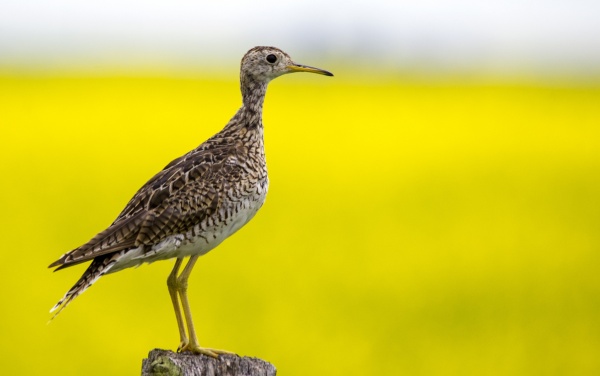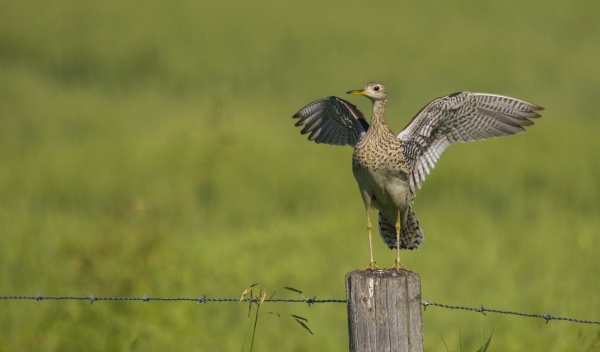
18 June 2014
Strip mining consumes nearly 3,000 acres of Pennsylvania every year but there’s a ray of hope when the mines are reclaimed. The “strips” become grasslands that could attract this bird.
Though they are “shorebirds” upland sandpipers don’t live at the shore. They’re the quintessential grassland bird and an indicator of healthy tallgrass prairie. Eight months of the year they live on the pampas (grasslands) of Argentina but in early spring they fly 6,000 to 8,000 miles, sometimes in as little as a week, to nest in the grasslands of North America. Present from April to August, they stay here only four months.
In this century it’s a privilege to see one. In the late 1800’s the upland plover, as it was called at the time, was market-hunted to fill the dining niche vacated by the suddenly scarce passenger pigeon. Trainloads of dead “plovers” were shipped East while settlers drained the prairie and converted it to farmland. Nowadays habitat loss and pesticides continue to threaten the bird’s existence. Bartramia longicauda is listed as endangered in Pennsylvania.
Upland sandpipers are magical birds. Your first hint of their presence may be a long mellow courtship whistle, given in flight or upon alighting (click here to hear), or their short whistle: “Ba-tui-tui.“
They are graceful in almost everything they do. In flight they use a distinctive rapid fluttering style reserved for the breeding grounds. Scan the fenceposts and you’ll find one perched where he landed with wings held aloft in a V, then slowly lowered. It’s worth waiting to see one do this. With its 20 inch wingspan, you can’t help but notice the bird.

Upland sandpipers are very picky about grass. They require upland, ungrazed grassland with three kinds of habitat: perches for courtship, tall vegetation with overhanging cover for the nest, low vegetation for their young to forage in. They are also picky about grass species, preferring native grasses to invasives. This means there are few places to find them in Pennsylvania.
The opportunity to see an upland sandpiper is so tempting, though, that birders will drive long distances to find them. When I read last week that they were seen in Clarion County I drove an hour and a half last Sunday, 15 June 2014, to meet up with Carole Winslow, Clarion County’s bird compiler. We found a birder from New Jersey who had driven 5 hours to find “uppies.” He was lured by the magic, too.
Carole and I were very lucky. We saw four upland sandpipers in a large field at Mt. Airy and as we drove away were startled to see one perched on a fencepost close to the road. Oh my! We stopped in our tracks. He took our breath away.
(Photos by Dan Arndt, Creative Commons license. Dan lives in Calgary and writes for two blogs: Birds Calgary and Bird Canada. His most recent blog celebrated Rachel Carson’s birthday (a native of the Pittsburgh area) with a photo of a peregrine. Woo hoo!)
Wow, those are great looking birds. And I like the Bobolink header too.
Kate–I know this is not on point but…I have found 2 dead birds in my yard this week. One was almost certainly a birdstrike (very near a large window) but the other (which looked like a young starling) was in the center of the yard, panting, with wings tucked under. It died shortly after.
Is there any report of resurgence of the virus that killed so many local birds several years ago? Any reason to be concerned?
Thanks
Anne
Anne, from your description these sound like unrelated incidents. In fact the young starling may have hit the window too but managed to move away & die later. I have not heard any news of viruses this year.
Hi Kate, wonderful Blog. Judi and I are heading up to camp in Belltown next weekend and would love to try and find these birds. Could you give some directions to where you spotted them. We know the area but Clarion is a big county. Doug
Doug & Judi, thanks for asking. I’ll email you.
Kate, loved the photos AND the commentary. You’re a great instructor! Would love to see these birds in our neck of the woods! Or fields!